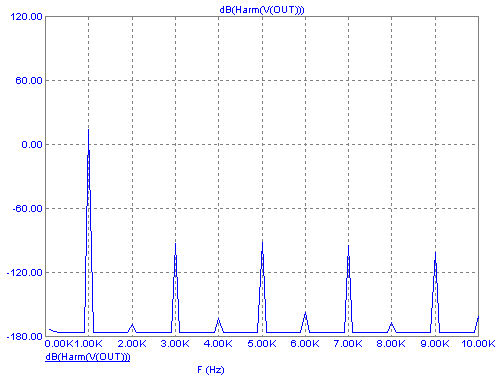|
|
 |
Periodic Steady State
Periodic steady state is a feature that is new to MC10. It computes steady state waveforms, eliminating
the transient part of the solution. Very often the steady state is the desired portion and the transient
portion merely a nuisance. Consider this voltage quadrupler circuit.
|
Here is its transient run over 10mSec. It's clear that the transient response will require
hundreds of 1ms periods to dissipate the initial transient to reach a steady state. In
fact more than 1000 1mS periods will be needed to achieve a steady state accurate to
less than 100uV.
|
Now consider this run using Periodic Steady State.
|
Here PSS has computed the steady state. It shows a ripple of about 200uV riding on a DC level of
about 398 volts. The original run using 1000 1mS periods took about 10 seconds. The PSS run took
about 1 second.
Now consider this circuit.
|
Here is its FFT without using PSS.
|
Here is its FFT with PSS.
|

|
You can see from the last FFT window plot that the circuit has a noise floor of about 175 dB and contains mainly odd harmonics.
Without PSS the odd harmonics are completely lost. This is due to the fact that without PSS the waveform being analyzed is not
really periodic. There are still initial transients present. With PSS the initial transient error is reduced to about 1nV and
with this small error it is possible for the FFT window to more accurately see smaller harmonics.
Here are some guidelines for using PSS:
Periodicity: The circuit response must be periodic. If it is driven by multiple sources, tmax must be an integer multiple of
the periods of those sources.
Linearity: The relationship between the initial and final points over the shooting interval must be near linear. With perfect linearity,
convergence usually occurs within 1-3 iterations. If the relationship is highly nonlinear many more iterations may be required or PSS
may not converge at all.
Non-chaotic Circuits: PSS cannot handle oscillators (unless the period is known) nor circuits that respond chaotically, such as delta-sigma
modulators and some SMPS circuits.
Limitations: PSS does not work with circuits containing digital components, transmission lines, Laplace sources,
Z-transform sources, or N-ports.
|
|
|
|
|






